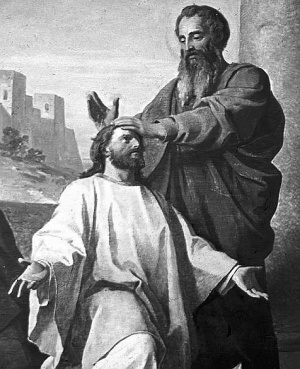Timothy: Difference between revisions
(Created page with "The author of First Timothy has been traditionally identified as Paul the Apostle . He is named as the author of the letter in the text (1:1). Nineteenth and twentieth cen...") |
mNo edit summary |
||
| (5 intermediate revisions by 2 users not shown) | |||
| Line 1: | Line 1: | ||
The author of First Timothy has been traditionally identified as [[Paul the Apostle]] . He is named as the author of the letter in the text (1:1). Nineteenth and twentieth century scholarship questioned the authenticity and believe what we have was created from another text some time in the late-first-to-mid-2nd century. | [[File:timothy.jpg|right|thumb|Timothy converted as a youth in Lystra in Asia Minor with his Jewess mother and grandmother with the arrival of Paul. Seven years later Paul ordained him as a fellow-worker of the [[Apostles]]. ]]The author of First Timothy has been traditionally identified as [[Paul the Apostle]]. He is named as the author of the letter in the text (1:1). Nineteenth and twentieth-century scholarship questioned the authenticity and believe what we have was created from another text some time in the late-first-to-mid-2nd century. | ||
Paul may have written an original and this present day manuscript is a product of others producing the same | Paul may have written an original and this present day manuscript of '''[[Timothy]]''' is a product of others producing the same content with another style. The genuineness of Pauline authorship was accepted by Church orthodoxy as early as c. 180 AD, as evidenced by the surviving testimony of Irenaeus and the author of the Muratorian. Possible allusions are found in the letters from Clement of Rome to the Corinthians (c. 95), [[Ignatius of Antioch]] to the Ephesians (c. 110) and [[Polycarp]] to the Philippians (c. 130). | ||
So the letter was around and was Pastorals in nature. Someone with good intentions may have updated the letter with references to Gnostic approach that was around at Paul's time but had not gained popular presence. Updating terms and style is not anymore | So the letter was around and was Pastorals in nature. Someone with good intentions may have updated the letter with references to Gnostic approach that was around at Paul's time but had not gained popular presence. Updating terms and style is not anymore an alteration than a translation itself. | ||
A critical examination of the Epistle and its conformity to the [[Gospel of the kingdom]] and the [[Holy Spirit]] is the final comparison and essential determining factor that should be relied upon. | |||
{{Timothy}} | {{Timothy}} | ||
| Line 15: | Line 17: | ||
<references /> | <references /> | ||
[[Category:1 Timothy]] | |||
[[Category:2 Timothy]] | |||
Latest revision as of 18:13, 3 December 2023

The author of First Timothy has been traditionally identified as Paul the Apostle. He is named as the author of the letter in the text (1:1). Nineteenth and twentieth-century scholarship questioned the authenticity and believe what we have was created from another text some time in the late-first-to-mid-2nd century.
Paul may have written an original and this present day manuscript of Timothy is a product of others producing the same content with another style. The genuineness of Pauline authorship was accepted by Church orthodoxy as early as c. 180 AD, as evidenced by the surviving testimony of Irenaeus and the author of the Muratorian. Possible allusions are found in the letters from Clement of Rome to the Corinthians (c. 95), Ignatius of Antioch to the Ephesians (c. 110) and Polycarp to the Philippians (c. 130).
So the letter was around and was Pastorals in nature. Someone with good intentions may have updated the letter with references to Gnostic approach that was around at Paul's time but had not gained popular presence. Updating terms and style is not anymore an alteration than a translation itself.
A critical examination of the Epistle and its conformity to the Gospel of the kingdom and the Holy Spirit is the final comparison and essential determining factor that should be relied upon.
Timothy
1 Timothy 1 | 1 Timothy 2 | 1 Timothy 3
1 Timothy 4 | 1 Timothy 5 | 1 Timothy 6
2 Timothy 1 | 2 Timothy 2 | 2 Timothy 3 | 2 Timothy 4
Bible |
Bible Index |
Bible References |
Biblical bunch |
Sophistry |
Modern Christians |
Whosoever believeth |
Religion |
Bible_terms |
Early non Bible authors
Athenagoras of Athens | Methodius of Olympus | Theophilus or Ignatius of Antioch
Hippolytus of Rome | Justin the Martyr | Jerome | Augustine of Hippo |
Epistle of Mathetes | Gospel of James | The Gospel of Thomas |
Philo Judaeus or Philo of Alexandria and The Allegories of the Sacred Laws
Polybius | Plutarch | Seneca | Tacitus | Suetonius |
Marcus Tullius Cicero | Celsus | Diotrephes |
People in the Bible
Paul the Apostle |
Melchizedek |
Moses |
Cain |
Caesar |
Herod |
Jesus |
John the Baptist |
Matthew |
Mark |
Luke |
John |
Nimrod |
Abraham |
Essenes |
Pharisees |
Sadducees |
Zealots |
Julius Caesar | Augustus Caesar | Tiberius | Nero |
Historical People
Buddha |
Constantine |
Eusebius |
Ambrose |
Augustine of Canterbury |
Lady Godiva |
Vespian |
Diocletian |
Manichaeism |
John Wycliffe |
If you need help:
- Or want to help others:
Join The Living Network of The Companies of Ten
The Living Network |
Join Local group |
About |
Purpose |
Guidelines |
Network Removal
Contact Minister |
Fractal Network |
Audacity of Hope |
Network Links